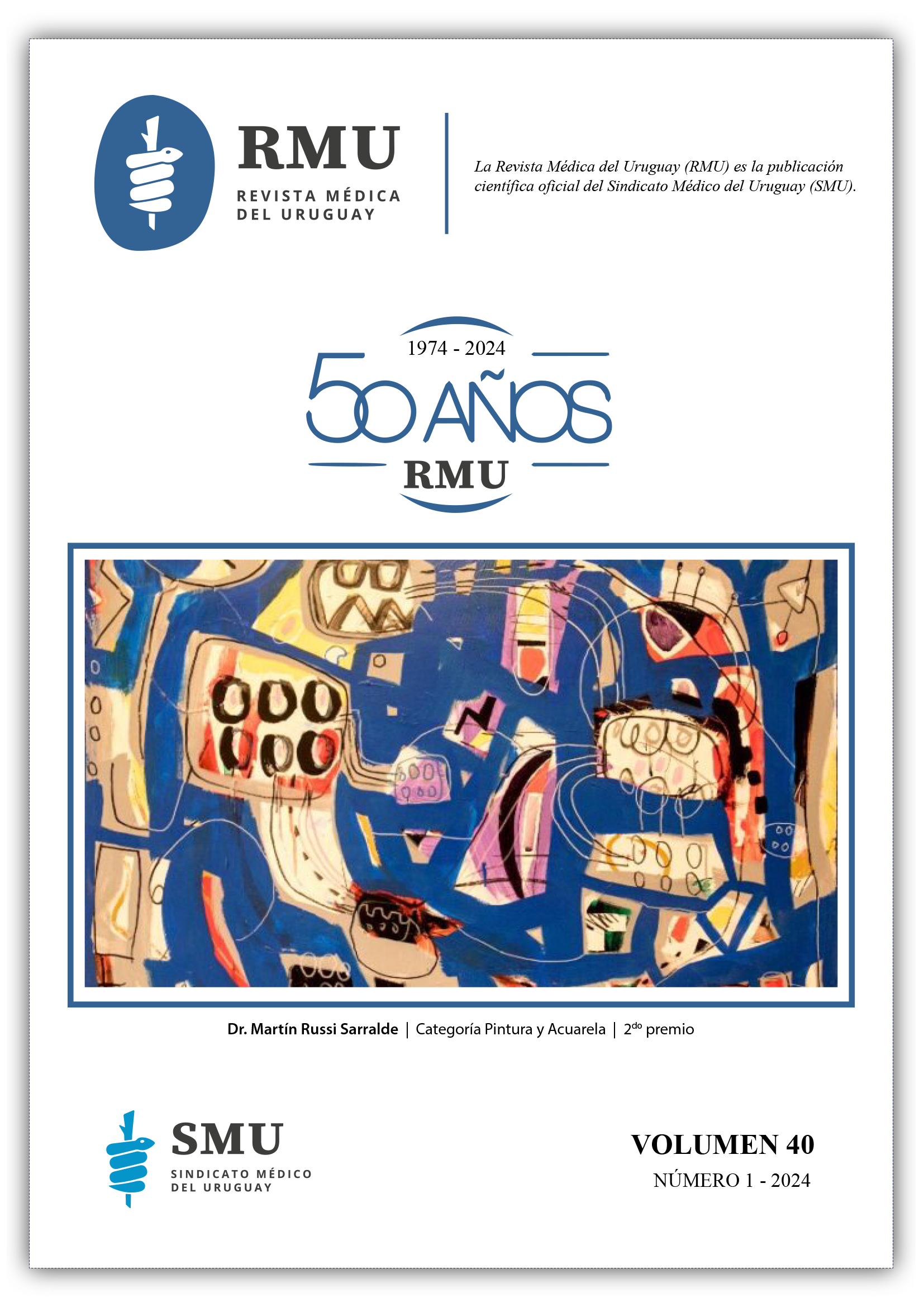Surgical experience at the Specialized Center for the Treatment of Skin Diseases (CETEP) at Pereira Rossell Hospital from 1996 to 2019
DOI:
https://doi.org/10.29193/RMU.40.1.1Keywords:
DERMATOLOGICAL SURGERY, SKIN TUMORS, SURGICAL TECHNIQUEAbstract
Cutaneous tumors have a high prevalence in dermatology worldwide, with benign tumors being more common than malignant ones. Nevertheless, the latter are more extensively studied due to their associated morbidity and mortality. The main objective of this study was to identify the primary diagnoses and corresponding surgical techniques developed at the Center for the Treatment of Skin Diseases (CETEP) between 1996 and 2019, while assessing clinical and demographic aspects. A retrospective, observational study was conducted, including all patients with cutaneous lesions and subsequent surgical resolution of the same. In the analyzed sample (N 6659), there was a predominance of females (68%), and the mean age was 53 ± 21 years. The majority of patients resided in Montevideo (58%). Benign tumors were the most prevalent (41%), followed by malignant tumors (28%), with the latter comprising basal cell carcinoma (BCC) at 66%, squamous cell carcinoma (SCC) at 21%, and melanoma (MM) at 5%. The performed surgical techniques included conventional surgeries (57%), primarily using the lozenge method (93%), followed by dermatologic surgery procedures (42%), with a predominance of biopsies (52%) and shave excision with electrocoagulation (23%). It is noteworthy that CETEP resolved a greater number of patients from external centers than from its own hospital, Pereira Rossell Hospital Center (CHPR). 59% non-CHPR vs. 41% CHPR. In conclusion, this study provided national information on the epidemiology of various cutaneous tumors, as well as the most commonly employed surgical techniques in their resolution Furthermore, it emphasized the importance of dermatologic surgery and highlighted the capacity of CETEP to respond to both its own patients and those referred from other centers within the public healthcare system.
References
Forman D, Sierra MS. Cancer in Central and South America: introduction. Cancer Epidemiol 2016; 44(Suppl 1):S3-S10. doi: 10.1016/j.canep.2016.04.008.
Sung H, Ferlay J, Siegel RL, Laversanne M, Soerjomataram I, Jemal A, Bray F. Global Cancer Statistics 2020: GLOBOCAN Estimates of Incidence and Mortality Worldwide for 36 Cancers in 185 Countries. CA Cancer J Clin 2021; 71(3):209-49. doi: 10.3322/caac.21660.
Comisión Honoraria de Lucha contra el Cáncer. Registro Nacional de Cáncer. Situación epidemiológica del Uruguay en relación al cáncer. Mayo 2023. Disponible en: https://www.comisioncancer.org.uy/Ocultas/Situacion-Epidemiologica-del-Uruguay-en-relacion-al-Cancer--2023-uc108. (Consulta: 23 diciembre 2023).
World Health Organization. International Agency for Research on Cancer. The Global Cancer Observatory. Non-melanoma skin cancer. December 2020. Disponible en: https://gco.iarc.fr/today/data/factsheets/cancers/17-Non-melanoma-skin-cancer-fact-sheet.pdf. (Consulta: 23 diciembre 2023).
World Health Organization. International Agency for Research on Cancer. The Global Cancer Observatory. Melanoma of skin. December 2020. Disponible en: https://gco.iarc.fr/today/data/factsheets/cancers/16-Melanoma-of-skin-fact-sheet.pdf. (Consulta: 23 diciembre 2023).
Comisión Honoraria de Lucha contra el Cáncer. Resumen Estadístico – MELANOMA. Incidencia y Mortalidad periodo 2015-2019. Tendencia de la Mortalidad hasta 2020. Disponible en: https://www.comisioncancer.org.uy/Ocultas/RESUMENES-ESTADISTICOS-paralos-canceres-mas-frecuentes--uc264. (Consulta: 20 diciembre 2023).
Uruguay. Universidad de la República. Facultad De Medicina. Escuela de Graduados. Programa de formación de especialistas en dermatología médico-quirúrgica. Aprobado por la Escuela de Graduados el 23 de octubre de 2009. Disponible en: http://www.egradu.fmed.edu.uy/sites/www.egradu.fmed.edu.uy/files//Programa_de_postgrados/3-Especialidades/DERMATOLOG%C3%8DA%20M%C3%89DICO%20-%20QUIR%C3%9ARGICA.pdf. (Consulta: 25 diciembre 2023).
Resnik S. History of dermatologic surgery. En: Roenigk & Roenigk’s Dermatologic surgery: principles and practice. 1989:3-4.
Grossi GP, Jacquier M, Quattrocchi CM, Dagatti MS, Bergero AI, Sánchez AE, et al. Estudio epidemiológico y de concordancia clínico–patológica del cáncer de piel en el Hospital Provincial del Centenario, Rosario, Argentina. Arch Argent Dermatol 2012; 62:179-84. Disponible en: https://1library.co/document/yr0xgg8y-estudio-epidemiologico-y-de-concordancia-clinico-patologica-del-cancer-de-piel-en-el-hospital-provincial-del-centenario-rosario-argentina.html. (Consulta: 20 diciembre 2023).
Rozhok A, DeGregori J. A generalized theory of age-dependent carcinogenesis. Elife 2019; 8:e39950. doi: 10.7554/eLife.39950.
Ramos P, Cañete F, Dullak R, Bolla L, Centurión N, Centurión A, et al. Epidemiología del cáncer de piel en pacientes atendidos en la Cátedra de Dermatología de la Facultad de Ciencias Médicas de la Universidad Nacional de Asunción, Paraguay (2008-2011). An Fac Cienc Méd (Asunción) 2012; 45(2):49-70. Disponible en: http://scielo.iics.una.py/pdf/anales/v45n2/v45n2a05.pdf. (Consulta: 25 diciembre 2023).
Güémez-Graniel MF, Plascencia-Gómez A, Graniel Lavadores MJ, Dzul Rosado K. Epidemiología del cáncer de piel en el Centro Dermatológico de Yucatán durante 2012. Dermatol Rev Mex 2015; 59(1):9-18. Disponible en: https://docplayer.es/41522690-Epidemiologia-del-cancer-de-piel-en-el-centro-dermatologico-de-yucatan-durante-2012.html. (Consulta: 20 diciembre 2023).
Harris RB, Griffith K, Moon TE. Trends in the incidence of nonmelanoma skin cancers in southeastern Arizona, 1985-1996. J Am Acad Dermatol 2001; 45(4):528-36. doi: 10.1067/mjd.2001.114742.
Basset-Séguin N, Chaussade V, Vilmer C. Carcinomas basocelulares. EMC-Dermatología 2011; 6:1-7. doi: 10.1016/S1761-2896(11)60405-6.
González VM, Busso PS, Leitner R, Casas G, Larralde M. Estudio epidemiológico del carcinoma basocelular en un hospital de la comunidad. Dermatol Argentina 2009; 15(1):37-43. Disponible en https://www.dermatolarg.org.ar/index.php/dermatolarg/article/view/190/87. (Consulta: 25 diciembre 2023).
J Bonerandi, Monestier S. Carcinoma epidermoide (espinocelular) y sus precursores. EMC-Dermatología 2011; 45(2):1-19.
doi: 10.1016/S1761-2896(11)71044-5.
Miller DL, Weinstock MA. Nonmelanoma skin cancer in the United States: incidence. J Am Acad Dermatol 1994; 30(5 Pt 1):774-8. doi: 10.1016/s0190-9622(08)81509-5.
López Gamboa VR, Bartoli J, Blanzari MJ, Vicente Campana R, Nocito MJ, Bringas A, et al. Estudio epidemiológico del cáncer cutáneo no melanoma en una institución de la ciudad de Córdoba, Argentina, en un periodo de cinco años. Med Cutan Iber Lat Am 2017; 45(2):107-11. Disponible en: https://www.medigraphic.com/pdfs/cutanea/mc-2017/mc172d.pdf. (Consulta: 25 diciembre 2023).
Sortino-Rachou AM, Curado MP, Cancela M de C. Melanoma cutâneo na América Latina: estudo descritivo de base populacional. Cad Saúde Pública 2011; 27(3):565-72. doi: 10.1590/S0102-311X2011000300016.
Raimondi S, Suppa M, Gandini S. Melanoma epidemiology and sun exposure. Acta Derm Venereol 2020; 100(11):adv00136. doi: 10.2340/00015555-3491.
Gaulding JV, Gutierrez D, Bhatia BK, Han X, Krajenta R, Neslund-Dudas C, et al. Epidemiology of skin diseases in a diverse patient population. J Drugs Dermatol 2018; 17(10):1032-36.
Córdoba S, Caballero I, Navalón R, Martínez-Sánchez D, Martínez-Morán C, Borbujo J. Analysis of operating room activities in the dermatology department at Hospital Universitario de Fuenlabrada (2005-2010). Actas Dermosifiliogr 2013; 104(1):38-43. doi: 10.1016/j.ad.2012.04.007.













